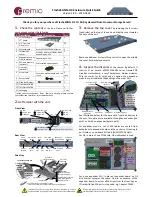
3Com Switch 8800 Configuration Guide
Chapter 20 Integrated IS-IS Configuration
20-4
20.1.3 NSAP Structure of IS-IS Routing Protocol
I. Address structure
AFI
IDI
High Order DSP
SyStem ID
SEL
(1 octet)
DSP
IDP
Area Address
Figure 20-2
NSAP structure
OSI adopts the address structure as shown in Figure 20-2. NSAP includes initial
domain part (IDP) and domain specific part (DSP). The IDP is defined by ISO; it
consists of authority responsible for assigning the rest of the address and address
format. The DSP is allocated by the authority specified in IDP. IDP and DSP are
length-variable with a total length of 20 bytes.
z
Area Address
IDP includes authority and format identifier (AFI) and initial domain identifier (IDI). AFI
defines the format of IDI. DSP has several bytes. The combination of IDP and HO-DSP
can identify a route area and an area of the route area, so the combination is called an
area address.
In general, you only need to configure an area address for a router. The area addresses
of all nodes are the same in an area. To support the seamless combination,
segmentation and conversion, the Switch 8800 supports up to three area addresses.
z
System ID
System ID uniquely identifies terminal system or router in a route area. You can select
length for it. The System ID length is 48 bits (6 bytes). In general, you can obtain
System ID according to Router_ID.
If the IP address 168.10.1.1 of the interface LoopBack0 serves as a router_ID for the
router, you can use the following method to obtain the System ID:
Turn each part of the IP address 168.10.1.1 into three digits. Add 0 to the front of the
part less than three digits.
Divide the expanded address 168.010.001.001 into three parts. Each part contains four
digits.
You get the System ID 1680.1000.1001.
You can specify a System ID using different methods. However, you should ensure a
System ID can uniquely identify a terminal system or a router.
















































